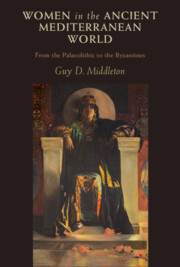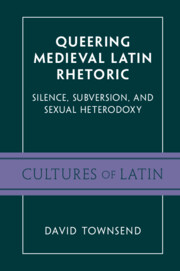Refine search
Actions for selected content:
23990 results in Ancient history
Chapter 19 - The Authority to Be Untraditional
- from Part V - Innovation within Tradition
-
-
- Book:
- The Authoritative Historian
- Published online:
- 02 December 2022
- Print publication:
- 26 January 2023, pp 373-391
-
- Chapter
- Export citation
Chapter 17 - How Tradition Is Formed
- from Part V - Innovation within Tradition
-
-
- Book:
- The Authoritative Historian
- Published online:
- 02 December 2022
- Print publication:
- 26 January 2023, pp 335-352
-
- Chapter
- Export citation
Chapter 11 - Veni, vidi, vici
- from Part III - Performing Collective and Personal Authority
-
-
- Book:
- The Authoritative Historian
- Published online:
- 02 December 2022
- Print publication:
- 26 January 2023, pp 224-240
-
- Chapter
- Export citation
Index Locorum
-
- Book:
- The Authoritative Historian
- Published online:
- 02 December 2022
- Print publication:
- 26 January 2023, pp 448-466
-
- Chapter
- Export citation
Chapter 2 - Folktale and Local Tradition in Charon of Lampsacus
- from Part I - Myth, Fiction, and the Historian’s Authority
-
-
- Book:
- The Authoritative Historian
- Published online:
- 02 December 2022
- Print publication:
- 26 January 2023, pp 41-61
-
- Chapter
- Export citation
Chapter 1 - Seven Types of Fiction in the Greek Historians
- from Part I - Myth, Fiction, and the Historian’s Authority
-
-
- Book:
- The Authoritative Historian
- Published online:
- 02 December 2022
- Print publication:
- 26 January 2023, pp 19-40
-
- Chapter
- Export citation
Chapter 6 - Interpretive Uncertainty in Herodotus’ Histories
- from Part II - Dislocating Authority in Herodotus’ Histories
-
-
- Book:
- The Authoritative Historian
- Published online:
- 02 December 2022
- Print publication:
- 26 January 2023, pp 121-138
-
- Chapter
- Export citation
Copyright page
-
- Book:
- The Authoritative Historian
- Published online:
- 02 December 2022
- Print publication:
- 26 January 2023, pp iv-iv
-
- Chapter
- Export citation
Part II - Dislocating Authority in Herodotus’ Histories
-
- Book:
- The Authoritative Historian
- Published online:
- 02 December 2022
- Print publication:
- 26 January 2023, pp 99-176
-
- Chapter
- Export citation
Chapter 16 - ‘When one assumes the ethos of writing history’
- from Part V - Innovation within Tradition
-
-
- Book:
- The Authoritative Historian
- Published online:
- 02 December 2022
- Print publication:
- 26 January 2023, pp 315-334
-
- Chapter
- Export citation
Chapter 3 - Mythical and Historical Time in Herodotus
- from Part I - Myth, Fiction, and the Historian’s Authority
-
-
- Book:
- The Authoritative Historian
- Published online:
- 02 December 2022
- Print publication:
- 26 January 2023, pp 62-81
-
- Chapter
- Export citation
General Index
-
- Book:
- The Authoritative Historian
- Published online:
- 02 December 2022
- Print publication:
- 26 January 2023, pp 467-476
-
- Chapter
- Export citation
Chapter 13 - Thucydides’ Mytilenaean Debate
- from Part IV - Generic Transformations
-
-
- Book:
- The Authoritative Historian
- Published online:
- 02 December 2022
- Print publication:
- 26 January 2023, pp 261-270
-
- Chapter
- Export citation
Chapter 15 - Tradition and Authority in Philostratus’ Lives of the Sophists
- from Part IV - Generic Transformations
-
-
- Book:
- The Authoritative Historian
- Published online:
- 02 December 2022
- Print publication:
- 26 January 2023, pp 292-312
-
- Chapter
- Export citation
Chapter 5 - Herodotus as Tour Guide
- from Part II - Dislocating Authority in Herodotus’ Histories
-
-
- Book:
- The Authoritative Historian
- Published online:
- 02 December 2022
- Print publication:
- 26 January 2023, pp 101-120
-
- Chapter
- Export citation
Preface
-
- Book:
- The Authoritative Historian
- Published online:
- 02 December 2022
- Print publication:
- 26 January 2023, pp xv-xv
-
- Chapter
- Export citation
Part III - Performing Collective and Personal Authority
-
- Book:
- The Authoritative Historian
- Published online:
- 02 December 2022
- Print publication:
- 26 January 2023, pp 177-258
-
- Chapter
- Export citation
Chapter 10 - Authority, Experience, and the Vicarious Traveller in Herodotus’ Histories
- from Part III - Performing Collective and Personal Authority
-
-
- Book:
- The Authoritative Historian
- Published online:
- 02 December 2022
- Print publication:
- 26 January 2023, pp 206-223
-
- Chapter
- Export citation

Women in the Ancient Mediterranean World
- From the Palaeolithic to the Byzantines
-
- Published online:
- 19 January 2023
- Print publication:
- 09 February 2023

Queering Medieval Latin Rhetoric
- Silence, Subversion, and Sexual Heterodoxy
-
- Published online:
- 15 January 2023
- Print publication:
- 05 January 2023
